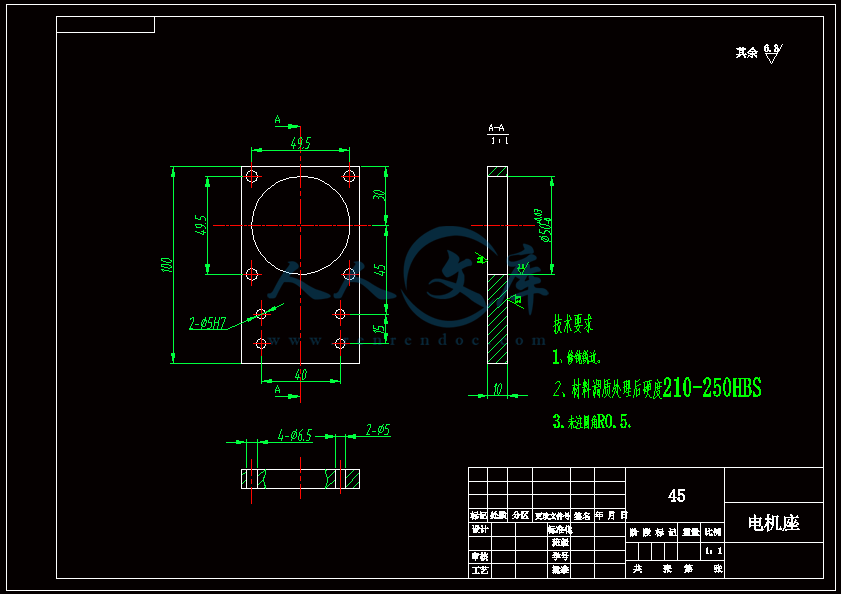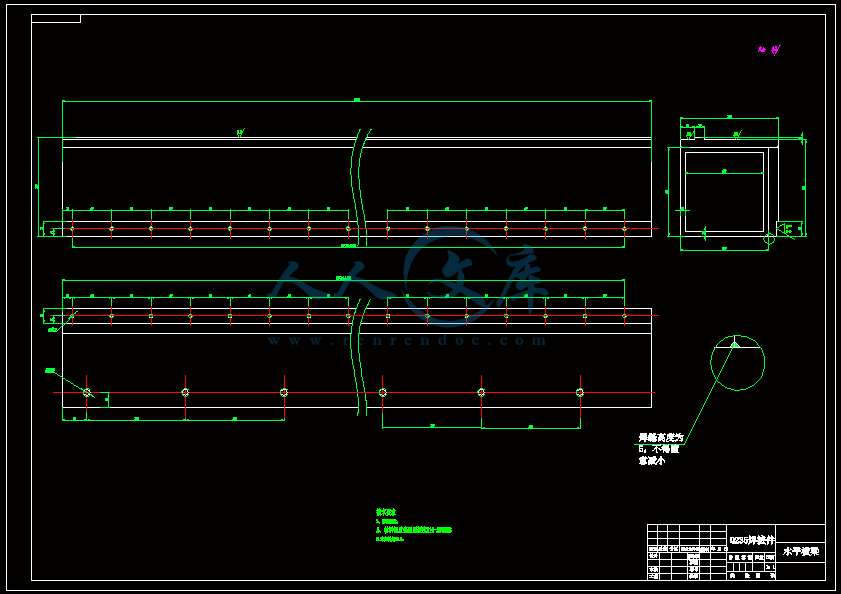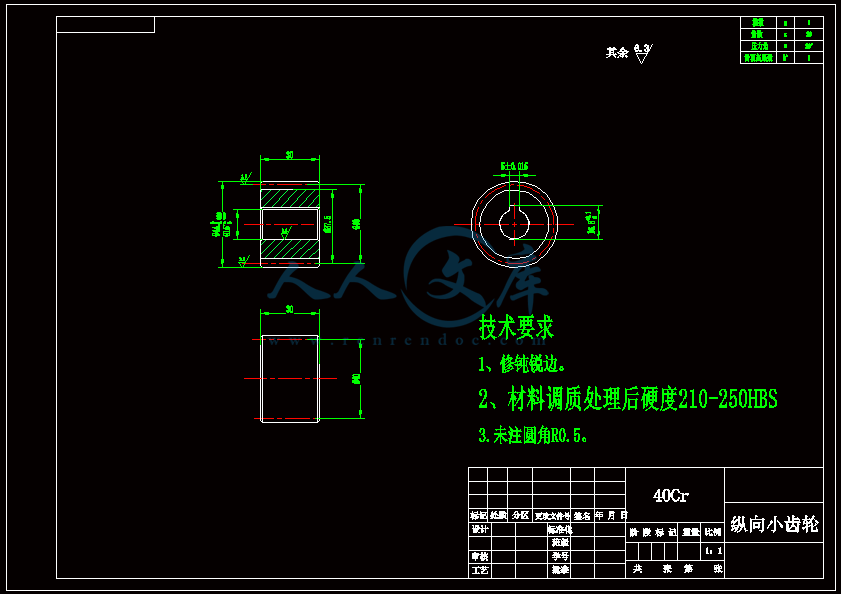Study of precision micro-holes in borosilicate glass using micro EDM combined with micro ultrasonic vibration machining.pdf
资源目录

压缩包内文档预览:
编号:15805140
类型:共享资源
大小:10.85MB
格式:ZIP
上传时间:2019-03-09
上传人:机****料
认证信息
个人认证
高**(实名认证)
河南
IP属地:河南
50
积分
- 关 键 词:
-
含CAD图纸、说明书
机械手设计图纸说明书
CAD图纸机械设计
CAD图纸说明
- 资源描述:
-













- 内容简介:
-
International Journal of Machine Tools received in revised form 10 May 2002; accepted 14 May 2002 Abstract Because of its excellent anodic bonding property and surface integrity, borosilicate glass is usually used as the substrate for micro-electro mechanical systems (MEMS). For building the communication interface, micro-holes need to be drilled on this sub- strate. However, a micro-hole with diameter below 200 m is diffi cult to manufacture using traditional machining processes. To solve this problem, a machining method that combines micro electrical-discharge machining (MEDM) and micro ultrasonic vibration machining (MUSM) is proposed herein for producing precise micro-holes with high aspect ratios in borosilicate glass. In the investigations described in this paper, a circular micro-tool was produced using the MEDM process. This tool was then used to drill a hole in glass using the MUSM process. The experiments showed that using appropriate machining parameters; the diameter variations between the entrances and exits (DVEE) could reach a value of about 2 m in micro-holes with diameters of about 150 m and depths of 500 m. DVEE could be improved if an appropriate slurry concentration; ultrasonic amplitude or rotational speed was utilized. In the roundness investigations, the machining tool rotation speed had a close relationship to the degree of micro- hole roundness. Micro-holes with a roundness value of about 2 m (the max. radius minus the min. radius) could be obtained if the appropriate rotational speed was employed. 2002 Elsevier Science Ltd. All rights reserved. Keywords: Borosilicate glass; Micro electrical-discharge machining; Micro ultrasonic vibration machining; Micro-hole; micro-tool; High aspect ratio 1. Introduction In packaging MEMS-related devices, such as micro valves and micro fl ow sensors etc., borosilicate glass is usually used as the substrate for bonding with silicon wafers. To build up the electrical through channel and connect the internal system between the silicon wafer and environment, micro-holes are drilled in the glass sur- face before they are bonded. Drilling these micro-holes is diffi cult with traditional machining processes. There are several methods used to manufacture micro-holes, MEDM 1,3,5,8,9,11, excimer laser drilling 6, LIGA 2,10, electrochemical discharge machining (ECDM) 12 and MUSM 4,7 etc. Because of the different work- ing mechanisms, the results produced by these methods are distinct. Correspondingauthor.Tel.:+886-3-4267353;fax:+886-3- 4254501. E-mail address: bhyen.tw (B.H. Yan). 0890-6955/02/$ - see front matter 2002 Elsevier Science Ltd. All rights reserved. PII: S0890-6955(02)00061-5 For example, in MEDM, a micro-hole with a diameter of 160 m and depth of 380 m could be drilled within 2 min 5. MEDM can be used to manufacture only con- ductive material and the recast layer on a machined sur- face, containing craters and micro cracks will cause poor surface and size accuracy. Laser micro machining tech- nology can be used to fabricate a hole under diameter of 4 m 6. However, laser beam machining causes deterioration and micro-cracks on the machined surface. The LIGA technique has been found suitable for produc- ing three-dimensional microstructures with micro-holes in metal, polymers and ceramics 2,10. However, the LIGA method affects the confi guration precision in micro-hole machining with high aspect ratios because of light diffraction (such as X-ray). ECDM can improve the material removal rate (MRR) and surface roughness to 1.5 mm/min and 0.08 m, respectively 12, but as with chemical etching, the walls of the micro-holes will be over etched due to the ECDM process. MUSM has been proved successful in hard and brittle material. Masuzawa et al. demonstrated that micro-holes as small as 5 m 1106B.H. Yan et al. / International Journal of Machine Tools OS, optical scale; OP, optical scale counter; X, Y and Z, motors for x-, y- and z-axes movement; Cu (copper plate), EDM electrode; H, rotating chuck holder; t, micro-tool; D, computer controlled display; C, motor for c-axis rotation; ID, interface circuit and motor driver; G, function generator; CPU, computer. and back direction using motor X and moved up and down using motor Y. The micro tool was clamped into a horizontal chuck rotated by motor C and directed left and right by motor Z. The movement resolutions of motors X, Y and Z were 0.2 m, 0.2 m and 0.5 m, respectively. To enable removing the debris easily from the micro-holes during MUSM, the machining operation was performed horizontally. The ultrasonic machining unit (frequency, 30 kHz) included an electronic gener- ator, a transducer and horn-tool combination equipment. The tool was a cylindrical rod screwed onto the horn tip. A small piece of borosilicate glass was chemically glued onto a small rectangular plate 4 attached to the tool tip (as shown in Fig. 2). 2.2. Materials Borosilicate glass (Pyrex, Corning 7740) is a silica composition with excellent anodic bonding property, surface integrity, thermal properties and acid resistance. This glass has always served as the substrate for micro sensors. Because borosilicate glass is hard and brittle, it is very suitable for micro-hole drilling using the MUSM method. For maintaining precise micro-hole sizes and shapes, the micro-tools must have high wear resistance and rigidity. A circular tungsten carbide rod with a diam- eter of 0.3 mm was selected as the MEDM and MUSM tool 4. Micro-hole precision can be improved by using oil as the slurry medium 1315. Silicon carbine grains, suspended in kerosene, were chosen as the working slurry whose concentrations were 10%, 20% and 30% in the MUSM process. And the averaged abrasive sizes were 1.2 m (about 75% particle sizes were from 0.9 to 1.5 m) and 3 m (about 75% particle sizes were from 2.6 to 3.4 m). 2.3. Machining procedures The machining processes were divided into two main parts. First, the tungsten carbide rod was fashioned into a micro-tool using a copper plate as electrode in the MEDM step. This tool was then used with the MUSM procedure to drill a micro-hole in the borosilicate glass. The above procedures are described in detail below: To EDM the micro-tool, the circular tungsten carbide rod was fi xed at horizontal direction and rotated clock- wise. At the same time, a copper plate was fastened to a jig and moved vertically up and down automatically. The diameter of the tool was reduced by the moving plate edge (as shown in Fig. 3(a) and the EDM dielec- tric was sprayed to the working area when MEDM was beginning. The completed micro-tool was 2 mm long and diameter 150 m. To produce high stress concen- tration in the workpiece during MUSM, the front end of the micro-tool was reduced in diameter to 20 m and length 0.2 mm. Fig. 3(b) displays the fi nished micro- 1107B.H. Yan et al. / International Journal of Machine Tools ? (fi nish) The open load voltage (V)100 Working voltage (V)25 Discharge current (A)0.95, 1.45 Pulse duration (s)4, 10 Off time (s)4, 10 ized to manufacture the glass with ultrasonic vibration (as shown in Fig. 2). The fl ow rate of slurry was 450 ml/min. Table 2 lists the experimental parameters for the MUSM processes. 3. Experimental results In addition to evaluating the size accuracy of high pre- cision micro-holes, the shape precision and surface roughness was estimated. Hence, the following dis- cussion is organized into three main parts: (A) diameter variation between the entrance and exit (DVEE), (B) roundness and (C) surface roughness. The factors affect- ing the precision of micro-holes include the slurry con- centration, abrasive grain size and the MUSM machin- ing parameters. 3.1. DVEE of micro holes In the MUSM processes, the micro-feeding method of micro-tool was applied to manufacture the micro-holes. In machining micro-holes with high aspect ratios, the tools could touch the walls of the holes for a long time, causing abrasion to the sides of the tools, or inducing irregular expansion of the micro-holes. These conditions will reduce the accuracy of the holes. DVEE of the micro-holes is an essential element in the MUSM pro- cess. The following sections utilize several MUSM para- meters to study the DVEE forming effects. Table 2 The experimental MUSM parameters Ultrasonic vibration directionLongitudinal Ultrasonic vibration frequency30 kHz Ultrasonic vibration amplitude (m)1.2, 1.4, 1.6, 1.8,2.0, 2.2 Rotational speed of micro tool (rpm)50, 100, 150, 200, 250 Feed rate (m/min)6, 6.7, 7.5, 8.6, 10 Concentration of slurry (wt %)10%, 20%, 30% Averaged abrasive size (m)1.2, 3 1108B.H. Yan et al. / International Journal of Machine Tools the front end of the tool produced more abrasion during this machining process. Hence, the DVEE became large. Fig. 9 shows a SEM photograph of the worn micro-tool. Fig. 9(a) represents the small circular step at the front end of the micro-tool seriously abraded from a larger feed rate machining (8.6 m/min). The tool suffered less wear at the same position when a smaller feed rate was used (6 m/min), as shown in Fig. 9(b). 3.2. Roundness In the USM processes, tool rotation or not, defi nitely infl uences the roundness of the holes 15,18. Tool rotation aids the suspended particles to enter the holes, thereby increasing the working effi ciency of the USM. Rotating tools can also induce the particles to grind the holes, thereby improving the roundness of the holes. In Fig. 8.The feed rate effect on DVEE via MUSM. 1110B.H. Yan et al. / International Journal of Machine Tools (c) was fi nished using an averaged grain of 1.2 m. These two fi gures clearly illustrate that the working sur- face still has a few craters and is not very smooth when the large grain size was used. The surface was very smooth with almost no craters when the small grain size was applied. Hence, the smaller abrasive particle sizes have a better effect on the micro-hole surface roughness. Fig. 12.The cross section and the surfaces of micro-holes via MUSM. (a) A cross section of micro-hole. (b) The surface of micro- hole produced using averaged size 3 m. (c) The surface of micro- hole produced using averaged size 1.2 m. 4. Conclusions For drilling micro-holes with high aspect ratios in borosilicate glass, a working method combining MEDM with MUSM was developed. Because the micro-tool was not dismantled from the clamping apparatus through varied working processes, a good tool concentricity level could be maintained in the machining procedures. Highly accurate micro-holes with diameters of about 150 m and depth of 500 m were manufactured via the MUSM method. The experiments revealed that the DVEE is infl uenced by the slurry concentration, ultrasonic vibration ampli- tude or rotational speed of the micro-tool. Values of these parameters exist at which DVEE is a minimum. Larger or smaller values cause DVEE to increase. Fur- thermore, smaller particle sizes or micro-tool feed rates produced better DVEE. In the MUSM processes, the micro-hole roundness had a close relationship to the micro-tool rotational speed. Experiments show the rotational speed effect on roundness is similar to the rotational speed effect on DVEE. Hence, for better micro-hole roundness, choos- ing the proper rotational speed is important. Moreover, the surface roughness of micro-holes was clearly affected by the size of the abrasive particles. Results obtained show that a fi ner surface roughness could be obtained when smaller abrasive particle sizes were used. Acknowledgements The authors would like to thank the National Science Council of the Republic of China for fi nancially support- ing this research under Contract No. NSC 89-2212-E- 008-049. References 1 K. Kagaya, Y. Oishi, K. Yada, Micro-electro discharge machin- ing using water as a working fl uid: micro-hole drilling, Precision Engineering 8 (3) (1986) 156162. 2 W. Ehrfeld, H. Lehr, Deep X-ray lithography for the production of three-dimensional microstructures from metals, polymers and ceramics, Radiation Physics and Chemistry 45 (3) (1995) 349 365. 3 D.M. Allen, A. Lecheheb, Micro electro-doscharge machining of ink jet nozzles: optimum selection of material and machining parameters, Journal of Materials Processing Technology 58 (1996) 5366. 4 X.-Q. Sun, T. Masuzawa, M. Fjino, Micro ultrasonic machining and its applications in MEMS, Sensors and Actuators A57 (1996) 159164. 5 D. Reynaerts, P.H. Heeren, H. Van Brussel, Microstructuring of silicon by electro-discharge machining (EDM) Part I: theory, Sensors and Actuators A60 (1997) 212218. 6 S.S. Choi, M.Y. Jung, D.W. Kim, M.A. Yakshin, J.Y. Park, Y. 1112B.H. Yan et al. / International Journal of Machine Tools & Manufacture 42 (2002) 11051112 Kuk, Fabrication and microelectron gun arrays using laser micromachining,MicroelectronicEngineering41-42(1998) 167170. 7 K. Egashira, T. Masuzawa, Microultrasonic machining by the application of workpiece vibration, Annals of the CIRP 48 (1) (1999) 131134. 8 H.M. Chow, C.T. Yang, B.H. Yan, F.Y. Huang, Fabrication of micro electrode of carbide and micro machining characteristics of Ti6Al4V alloy by electrical discharge machining, Journal of Japan institute of Light Metal 49 (1) (1999) 27. 9 B.H. Yan, F.Y. Huang, H.M. Chow, J.Y. Tsai, Micro-hole mac
- 温馨提示:
1: 本站所有资源如无特殊说明,都需要本地电脑安装OFFICE2007和PDF阅读器。图纸软件为CAD,CAXA,PROE,UG,SolidWorks等.压缩文件请下载最新的WinRAR软件解压。
2: 本站的文档不包含任何第三方提供的附件图纸等,如果需要附件,请联系上传者。文件的所有权益归上传用户所有。
3.本站RAR压缩包中若带图纸,网页内容里面会有图纸预览,若没有图纸预览就没有图纸。
4. 未经权益所有人同意不得将文件中的内容挪作商业或盈利用途。
5. 人人文库网仅提供信息存储空间,仅对用户上传内容的表现方式做保护处理,对用户上传分享的文档内容本身不做任何修改或编辑,并不能对任何下载内容负责。
6. 下载文件中如有侵权或不适当内容,请与我们联系,我们立即纠正。
7. 本站不保证下载资源的准确性、安全性和完整性, 同时也不承担用户因使用这些下载资源对自己和他人造成任何形式的伤害或损失。

人人文库网所有资源均是用户自行上传分享,仅供网友学习交流,未经上传用户书面授权,请勿作他用。
|
2:不支持迅雷下载,请使用浏览器下载
3:不支持QQ浏览器下载,请用其他浏览器
4:下载后的文档和图纸-无水印
5:文档经过压缩,下载后原文更清晰
|
 川公网安备: 51019002004831号
川公网安备: 51019002004831号